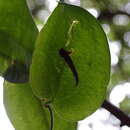Comprehensive Description
provided by Smithsonian Contributions to Zoology
Arctopoda maculosa Butler
Arctopoda maculosa Butler, 1883:67, pl. 11: fig. 5, female.—Bartlett-Calvert, 1886:344; 1893, pl. 2: fig. 2.—Meyrick, 1922b:138.
Polypseustis cuprea Dognin, 1908:33.
Male genitalia slides 24293, 24294, 24295, 24296, 24297, 24298. Harpe almost as broad as long; basal half strongly sclerotized; sacculus heavily sclerotized and produced distally as a blunt, flattened process; cucullus rounded. Gnathos elongate, sharply pointed. Uncus triangular, pointed. Vinculum rounded. Tegumen quadrate, nearly as broad as long. Anellus a quadrate plate with a digitate process from each posterior corner. Aedeagus nearly straight, slightly dilated proximally; vesica armed with a single cornutus.
Female genitalia slides USNM 24299, 24300. Ostium transverse, slitlike. Antrum rugose. Inception of ductus seminalis slightly before antrum. Ductus bursae membranous, short, slightly longer than bursa copulatrix. Bursa copulatrix membranous. Signum absent.
HOLOTYPES.—British Museum (Natural History) (A. maculosa); National Museum of Natural History, Smithsonian Institution (P. cuprea).
TYPE-LOCALITIES.—Las Zorras (A. maculosa): Valdivia (P. cuprea).
The following genus and species deserve special attention since the species belongs to a group previously known from Africa, Mascarene Islands, Mauritius, India, China, and Ceylon (Sri Lanka). For this group Meyrick proposed the family Metachandidae (1911:275) and based his family on the absence of vein 7 in the forewing and the absence of vein 6 in the hind wing. The characters on which Meyrick based his family are not always as interpreted by him: Six genera (Clarke, 1965:439–468), Ancylometis, Cenarchis, Chanystis, Metachanda, Stereoptila, and Therapnis, lack vein 7 in forewing as stated but all of these except Therapnis have vein 6 in the hind wing. Semnocosma Meyrick (1924:548) and Protochanda both have vein 7 of forewing present and Semnocosma has vein 6 of hind wing present. Because of the signum, however, it is doubtful that Semnocosma belongs in this group. According to Meyrick, Daemonarcha (1918: 27), has both 7 of forewing and 6 of hind wing absent. I have not seen the type of this genus (cyprophanes Meyrick). Obviously, then, except in two cases, Meyrick's family characters break down.
Hodges (1974:97) has reduced the family Metachandidae to synonymy in the Oecophoridae in the tribe Oecophorini, subfamily Oecophorinae. Although I do not dispute the family association, I would place this group as a subfamily Metachandinae, new status, of the Oecophoridae based on the strikingly different signum, as far as I know, found nowhere else in the Oecophoridae.
Philomusea Meyrick
Philomusea Meyrick, 1931:394. [Type-species: Philomusea craterias Meyrick, 1931; by original designation.]
Following is a rediagnosis of this genus.
Labial palpus recurved, exceeding vertex; second and third segments of about equal length; second segment roughened anteriorly; third segment acute. Tongue well developed; maxillary palpus minute, free. Head smooth; ocellus absent. Antenna simple but slightly serrulate distad; pecten absent. Thorax smooth. Forewing smooth, costa nearly straight, termen rounded, 12 veins; 1b furcate, 1c strongly preserved; 2 from well before angle; 3, 4, and 5 equidistant; 6 to apex; 7 and 8 long stalked, 7 to costa; 9 nearer to stalk of 7 and 8 than to 10; 11 from two-fifths of cell. Hind wing with 8 veins; 2 remote; 3 and 4 short stalked from angle of cell; 5 nearer to stalk of 3 and 4 than to 6. Hind tibia roughened with hairlike scales, especially at spurs. Abdominal terga not setose.
Male genitalia with well-developed gnathos and reduced uncus. Vesica with cornutus.
Female genitalia with well-developed signum.
Philomusea is closely related to Cenarchis Meyrick, from Rodriguez Island in the Mascarene group, in the Indian Ocean, but differs from it by having veins 7 and 8 of forewing stalked, not coincident, and by having veins 3 and 4 of hind wing short stalked, not coincident as in Cenarchis. Moreover, vein 6 of hind wing is well developed in Philomusea, not weakly so as in Cenarchis. Because of the retention of vein 7 (stalked with 8) of forewing and vein 6 of hind wing this might be considered the most primitive genus of the group.
- bibliographic citation
- Clarke, J. F. Gates. 1978. "Neotropical Microlepidoptera, XXI : new genera and species of Oecophoridae from Chile." Smithsonian Contributions to Zoology. 1-80. https://doi.org/10.5479/si.00810282.273

